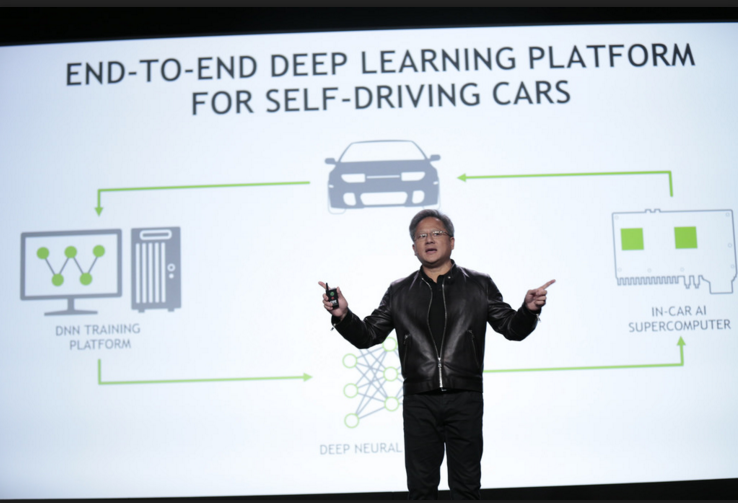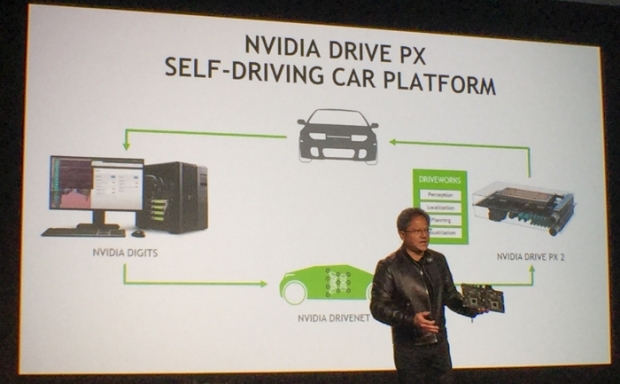Jen-Hsun introduced a new delivery model called “Personal Mobility as a Service” (PMaS) that envisions an automotive platform where cars can leverage the power of a personal supercomputer to increase road safety, increase driving efficiency, and hopefully prevent and lower the daily number of collision statistics with other drivers.
“Humans are the least reliable part of the car,” said Jen-Hsun Huang as he outlined three important challenges facing drivers. Car crashes – an estimated 93 percent of which are caused by human error – kill 1.3 million drivers each year. Secondly, there is a productivity issue. For example, Americans waste roughly 5.5 billion hours of time each year stuck in traffic. This results in an economic inefficiency costing the U.S. economy about $121 billion, according to Urban Mobility Report from Texas A&M. Third, there is an inefficiency of monetary funds spent on improving roads and highways that could be better targeted toward more efficient traffic patterns.
Jen-Hsun Huang says that Deep Learning through deep neural networks is the answer to the perception problem in complex uncertainties. Complex navigation data sets that require trillions and trillions of operations to train typically take months to calculate. Now, using Deep Learning with backpropagation and stochastic gradient descent, those same data sets can be crunched in just days.
Deep-learning software basically mimics the activity in layers of neurons in the human brain’s frontal neocortex (frontal and parietal lobes), the wrinkly 80 percent of the brain where thinking occurs. The software learns to recognize patterns in digital representations of sounds, images and other sensory patterns in the environment. Nvidia claims that Deep Learning is as large of a breakthrough as mobile computing and even the Internet itself. According to Jen-Hsun and MIT, the big breakthrough happened in 2013.
In order to tackle the infinite amounts of variables that face automotive drivers on the road, a Deep Learning machine needs to react to things such as stray pets, swerving cars, road construction crews, new road paint on top of old faded paint lines and many other complex programming challenges.
DIGITS – Nvidia’s Deep Learning Solution
Nvidia’s solution is called DIGITS (Deep Learning GPU Training System), a supercomputer that can be used to train digital neural networks by exposing them to data collected during that time on the road. Nvidia DIGITS is part of the company’s Deep Learning SDK, runs on the GeForce GTX TITAN X and can be downloaded here.
With 336.5GB/s of memory bandwidth, a single TITAN X GPU can process millions of pieces of data used to train deep neural networks. On AlexNet, an industry-standard model, TITAN X took less than three days to train the model using a 1.2 million image ImageNet dataset, compared with over 40 days for a 16-core CPU.
Nvidia DIGITS is then connected to Nvidia DriveWorks, a suite of software tools, libraries and modules that accelerates development and testing of autonomous vehicles.
Jen-Hsun also took time to remind the audience that machines are already beating humans at image recognition tasks. For example, systems trained with deep learning techniques can now correctly classify images more than 96 percent of the time.
During the event, Huang reminded the audience that machines are already beating humans at tasks once considered impossible for computers, such as image recognition. Systems trained with deep learning can now correctly classify images more than 96 percent of the time, exceeding what humans can do on similar tasks.
All in all, we agree that Deep Learning is perhaps one of the biggest achievements in computer science of the past decade and are very excited for the next ten years of automotive technology as Moore’s Law continues to scale into the future and give us GPU performance consistent with what Gordon Moore originally envisioned back in 1965.

